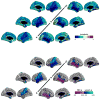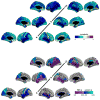The Emergence of Network Inefficiencies in Infants With Autism Spectrum Disorder
- PMID: 28460842
- PMCID: PMC5524449
- DOI: 10.1016/j.biopsych.2017.03.006
The Emergence of Network Inefficiencies in Infants With Autism Spectrum Disorder
Abstract
Background: Autism spectrum disorder (ASD) is a developmental disorder defined by behavioral features that emerge during the first years of life. Research indicates that abnormalities in brain connectivity are associated with these behavioral features. However, the inclusion of individuals past the age of onset of the defining behaviors complicates interpretation of the observed abnormalities: they may be cascade effects of earlier neuropathology and behavioral abnormalities. Our recent study of network efficiency in a cohort of 24-month-olds at high and low familial risk for ASD reduced this confound; we reported reduced network efficiencies in toddlers classified with ASD. The current study maps the emergence of these inefficiencies in the first year of life.
Methods: This study uses data from 260 infants at 6 and 12 months of age, including 116 infants with longitudinal data. As in our earlier study, we use diffusion data to obtain measures of the length and strength of connections between brain regions to compute network efficiency. We assess group differences in efficiency within linear mixed-effects models determined by the Akaike information criterion.
Results: Inefficiencies in high-risk infants later classified with ASD were detected from 6 months onward in regions involved in low-level sensory processing. In addition, within the high-risk infants, these inefficiencies predicted 24-month symptom severity.
Conclusions: These results suggest that infants with ASD, even before 6 months of age, have deficits in connectivity related to low-level processing, which contribute to a developmental cascade affecting brain organization and eventually higher-level cognitive processes and social behavior.
Keywords: Autism; Connectivity; Development; Efficiency; Infant siblings; Network analysis.
Copyright © 2017 Society of Biological Psychiatry. Published by Elsevier Inc. All rights reserved.
Conflict of interest statement
The authors report no biomedical financial interests or potential conflicts of interest.
Figures




Comment in
-
Noisy Networks and Autism.Biol Psychiatry. 2017 Aug 1;82(3):152-154. doi: 10.1016/j.biopsych.2017.05.011. Biol Psychiatry. 2017. PMID: 28693736 No abstract available.
References
-
- American Psychiatric Association. Diagnostic and statistical manual of mental disorders. 5. Arlington, VA: American Psychiatric Publishing; 2013.
-
- Osterling J, Dawson G. Early recognition of children with autism: A study of first birthday home videotapes. Journal of Autism and Developmental Disorders. 1994;24:247–257. - PubMed
-
- Maestro S, Muratori F, Cavallaro MC, Pei F, Stern D, Golse B, et al. Attentional skills during the first 6 months of age in autism spectrum disorder. Journal of the American Academy of Child & Adolescent Psychiatry. 2002;41:1239–1245. - PubMed
-
- Zwaigenbaum L, Bryson S, Rogers T, Roberts W, Brian J, Szatmari P. Behavioral manifestations of autism in the first year of life. International Journal of Developmental Neuroscience. 2005;23:143–152. - PubMed
-
- Brian J, Bryson S, Garon N, Roberts W, Smith I, Szatmari P, et al. Clinical assessment of autism in high-risk 18-month-olds. Autism. 2008;12:433. - PubMed
Publication types
MeSH terms
Grants and funding
LinkOut - more resources
Full Text Sources
Other Literature Sources
Medical
Research Materials
Miscellaneous

